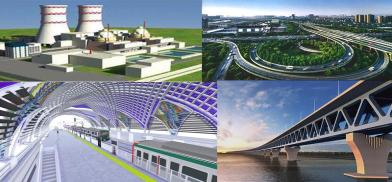Bangladesh megaprojects can be economic game-changers, but cost and corruption are major challenges
Bangladesh is trying to utilize megaprojects as a lever to turn the country into a lucrative investment destination, writes Kazi Mohammad Jamshed for South Asia Monitor

Past experiences have shown that megaprojects may become landmarks for a country by making a transformational impact on the lives of long-deprived people. Infrastructural megaprojects are material drivers for accelerating the economic growth of developing countries, especially during their transition to becoming developed nations.
As Bangladesh is on the highway to graduating from a Least Developed Country (LDC), it has adopted the much-talked-about megaproject culture - a tendency to combine multiple projects into one megaproject. Though Bangladesh’s success story, especially in managing funds for big-ticket megaprojects, has been applauded worldwide, criticism arises on the prudency of these investment decisions. How wise are these investment decisions?
By prioritizing eight mega infrastructural initiatives as fast-track projects, Bangladesh is basically planting the seeds for a sustainable future. These projects are Padma Bridge and Rail Link, Metro Rail, Chattogram-Cox’s Bazar Rail Link, Rooppur Nuclear Power Plant, The Coal-Fired Power Plant of Matarbari and Rampal, and the Payra Sea Port.
To realize the vision-2041 of becoming a developed country, Bangladesh is giving a big push for timely implementation of its “flagship projects” since these are expected to raise the country’s Gross Domestic Product – total value of goods and services produced in the country - by 4 percent upon successful completion. Even amidst an economic fallout triggered by Covid-19, the construction of the megaprojects is going on in full swing to set the stage for an economic take-off.
Triggering investment boom
The ongoing megaprojects are intended to make the country exceptionally rewarding in terms of economic margin and safe investment by upgrading existing physical infrastructure and creating an exemplary business environment.
The outlay of a big chunk of resources on megaprojects has triggered the biggest investment boom in Bangladesh’s history - showcasing economic rise and development records. These staggering projects are expected to transform the economic face of the country by opening up new business horizons and acting as an economic development engine. For instance, the Padma Bridge will connect 21 southern districts with the capital, thereby ensuring a cheap and regular supply of raw materials needed for industrialization; the Matarbari port will boost cross-border trade by facilitating speedy port service and integrated connectivity.
These multi-billion-dollar projects are expected to generate sustainable returns. The government’s effort to mobilize the investors and donors, to ensure “hefty investment” for the megaprojects, has created a big financial space for hard infrastructure development.
Bangladesh is trying to utilize megaprojects as a lever to turn the country into a lucrative investment destination by offering tangible benefits like logistics support, and non-tangible benefits like a competitive environment.
These signature projects, if properly managed, will successfully address Bangladesh’s infrastructure deficiencies, transport crises, and power shortages in a sustainable manner.
Debate on community impact
But the “iron law of megaprojects - over budget, over time, over and over again” created the “megaprojects paradox”- giving birth to two opposite schools of thought regarding their impact on the community.
One school criticizes megaprojects, questioning financial viability and complaining about cost overrun, environmental degradation, and overburdening the external debt. The other school justifies megaprojects, arguing the government usually conducts extensive “cost-benefit analysis” before initiating any giant project and cancels it if it is not economically viable or environmentally sustainable. An example is Bangladesh’s decision to scrap the Sonadia deep sea-port project.
Investing in megaprojects to stimulate economic development has been one of the most popular policy instruments since the 1930's great depression. Even the “Sustainable Development Goals Framework” emphasized spending about USD 57 trillion on infrastructure by 2030 to ensure the desired global GDP growth.
Bangladesh envisaged implementing large infrastructure megaprojects, even before Agenda 2030 was adopted, to make the country an investment hotspot of South Asia. East Asian Tigers – South Korea, Taiwan, Hong Kong, and Singapore - in their early days of development, invested heavily in “ground-breaking megaprojects” to deliver economic and social goods to the masses.
To give momentum to the economy and change the course of national progress, Bangladesh is following in the footsteps of the East Asian Tigers, who achieved a miracle of economic transformation. Bangladesh may also take lessons from the Gyeongbu Expressway of South Korea to generate optimum output from megaprojects.
High expectations, challenges
These projects are expected to be economic game-changers through revenue generation for maintenance and capital accumulation for future funding to push up growth rate to double digits. These trait-making projects will change the social structure and landscape by exploiting the phenomenon of economies of scale. The gravest challenge is to address cost escalation because of the snail's progress in construction, redress red tape and prevent fund embezzlement to ensure the initiatives do not turn into leaky buckets. The authorities also need to address issues like complacency, too much complexity and poor execution that could result in the projects going off the rails.
A megaproject is not the panacea to all the infrastructural deficiencies, rather it is one of the best available alternatives. It is the responsibility of the government to ensure the cost underestimation and benefit overestimation tendency is avoided while planning. Megaproject promoters, while promoting their pet projects, should be handled carefully since they may create a distorted hall-of-mirrors making it difficult to decide the projects needed to be taken up. It is the best project that should be implemented, not the one that looks best on paper.
These epoch-making initiatives of Bangladesh signal the beginning of a journey that can shed more light on the path towards larger prosperity.
(The writer, a strategic affairs and foreign policy analyst, is a lecturer at the Department of International Business, University of Dhaka. The views expressed are personal. He can be contacted at kazi.duib@gmail.com)
breakfast coming again to read further news.










Post a Comment